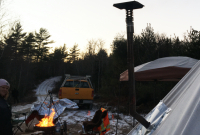Rare lichen puts temporary stop to cutblock in Nova Scotia

A group of people camped out in the snowy Nova Scotia wilderness to save a patch of forest have received their first piece of positive news since they started in early December.
A temporary halt has been placed on logging in the area by the provincial government after three species of lichen classified as “species at risk” were spotted near the group’s camp. Wrinkled shingle lichen, frosted glass-whiskers and black-foam lichen were all reported in the forest by a visiting lichen enthusiast, who then sent their findings to the Atlantic Canada Conservation Data Centre.
On Crown land, the patch in question is set to be logged by WestFor, a forestry group that supplies lumber to 13 mills in the province. Since Dec. 2, a handful of people have slept overnight among oak and pine trees in canvas tents — through Christmas holidays and multiple snowstorms. They refer to it as the “Last Hope Wildlife Corridor.”

The 80-year-old parcel is relatively small at 60 acres, or around 45 football fields, explained Nina Newington, a camper who has been there since the beginning. However, it’s some of the last standing forest in the area, which has seen ample clear-cuts. The trees are important habitat for species in the area, such as the wood turtle and the pine marten.
Since starting the camp, the group said they’ve received no official news from the government or WestFor on when the cut is set to happen. The MLA for the area, Carman Kerr, who is also the Liberals’ forestry critic, has said he thinks the cut should not happen.
Canada’s National Observer reached out to WestFor for comment, but did not receive a response in time for publication.
The three types of lichen are species at risk, which means there would need to be a 100-metre buffer zone around them if confirmed by the Nova Scotia Department of Natural Resources and Renewables. The main threat to black-foam lichen is deforestation, according to the federal government, which has designated the species as threatened since 2015.
Across the country, around 2,500 species of lichen exist in myriad environments, according to Nature Canada. In forests, some play an important role — they fix nitrogen for the soil, prevent erosion through soil stabilization and give habitat to insects. Lichens, a combination of algae and a fungus, are considered a keystone species in many areas and can even be used to measure air quality.

Although Newington is gravely concerned about the state of forestry in Nova Scotia, especially in light of last year’s review of the Lahey Report, she hopes this is a step towards this block being saved.
“It's cheering in the sense that it's a first step towards the government acknowledging that this is an ecologically valuable forest and it should be protected. It should not have been made available for harvesting,” said Newington.
In an email, the Department of Natural Resources and Renewables confirmed it was “alerted to potential occurrences of a rare lichen” and that the department has placed a temporary hold on the harvest plan as of Jan. 21. A lichenologist will survey the area and is expected to have the work finished in the next week.
“The department will take necessary steps to protect and conserve species at risk. Buffer zones will be applied to any confirmed occurrences of lichen, in accordance with Special Management Practices for this species at risk, prior to the temporary hold on harvest approval being released,” read part of the statement.
Depending on where and how many lichens there are, the buffer zones could make it difficult to harvest the forest. It's also possible WestFor could cut around the areas.
For Newington, who says the camp will remain through any temporary halt, the news underscores the need for more surveying before cuts are given the green light.
“Before they're allowing these harvests, they should, in fact, be doing a lot more investigation into each of these areas," she said.
"And they might not be able to send out an expert to every single area, but you could argue they should."






Comments
Thank you for this report.
I hope this works for you in Nova Scotia. It didn't work here with the specklebelly lichen in the Fairy Creek area of BC.